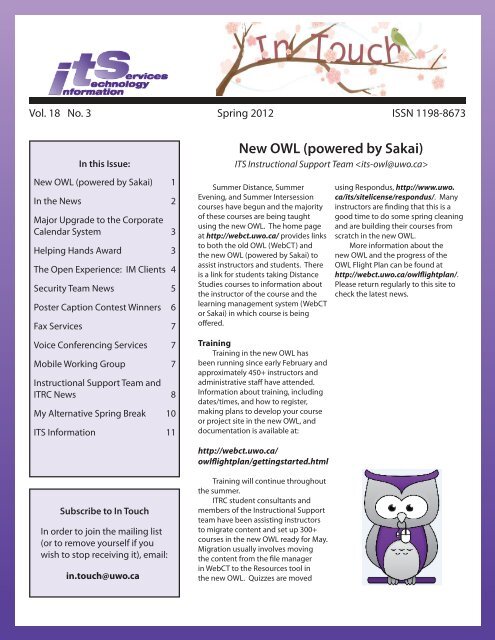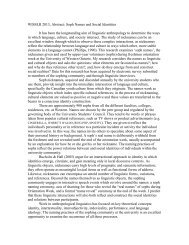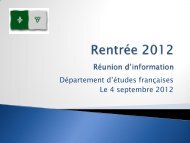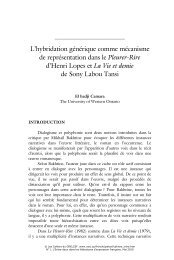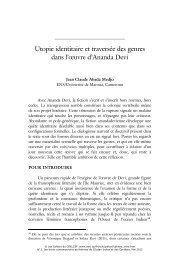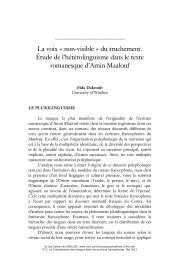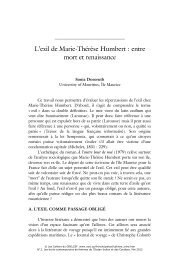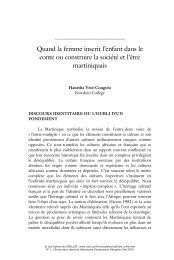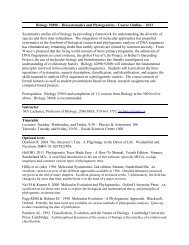New OWL (powered by Sakai) - University of Western Ontario
New OWL (powered by Sakai) - University of Western Ontario
New OWL (powered by Sakai) - University of Western Ontario
You also want an ePaper? Increase the reach of your titles
YUMPU automatically turns print PDFs into web optimized ePapers that Google loves.
Vol. 18 No. 3 Spring 2012 ISSN 1198-8673<br />
In this Issue:<br />
<strong>New</strong> <strong>OWL</strong> (<strong>powered</strong> <strong>by</strong> <strong>Sakai</strong>) 1<br />
In the <strong>New</strong>s 2<br />
Major Upgrade to the Corporate<br />
Calendar System 3<br />
Helping Hands Award 3<br />
The Open Experience: IM Clients 4<br />
Security Team <strong>New</strong>s 5<br />
Poster Caption Contest Winners 6<br />
Fax Services 7<br />
Voice Conferencing Services 7<br />
Mobile Working Group 7<br />
Instructional Support Team and<br />
ITRC <strong>New</strong>s 8<br />
My Alternative Spring Break 10<br />
ITS Information 11<br />
Subscribe to In Touch<br />
In order to join the mailing list<br />
(or to remove yourself if you<br />
wish to stop receiving it), email:<br />
in.touch@uwo.ca<br />
<strong>New</strong> <strong>OWL</strong> (<strong>powered</strong> <strong>by</strong> <strong>Sakai</strong>)<br />
ITS Instructional Support Team <br />
Summer Distance, Summer<br />
Evening, and Summer Intersession<br />
courses have begun and the majority<br />
<strong>of</strong> these courses are being taught<br />
using the new <strong>OWL</strong>. The home page<br />
at http://webct.uwo.ca/ provides links<br />
to both the old <strong>OWL</strong> (WebCT) and<br />
the new <strong>OWL</strong> (<strong>powered</strong> <strong>by</strong> <strong>Sakai</strong>) to<br />
assist instructors and students. There<br />
is a link for students taking Distance<br />
Studies courses to information about<br />
the instructor <strong>of</strong> the course and the<br />
learning management system (WebCT<br />
or <strong>Sakai</strong>) in which course is being<br />
<strong>of</strong>f ered.<br />
Training<br />
Training in the new <strong>OWL</strong> has<br />
been running since early February and<br />
approximately 450+ instructors and<br />
administrative staff have attended.<br />
Information about training, including<br />
dates/times, and how to register,<br />
making plans to develop your course<br />
or project site in the new <strong>OWL</strong>, and<br />
documentation is available at:<br />
http://webct.uwo.ca/<br />
owlfl ightplan/gettingstarted.html<br />
Training will continue throughout<br />
the summer.<br />
ITRC student consultants and<br />
members <strong>of</strong> the Instructional Support<br />
team have been assisting instructors<br />
to migrate content and set up 300+<br />
courses in the new <strong>OWL</strong> ready for May.<br />
Migration usually involves moving<br />
the content from the fi le manager<br />
in WebCT to the Resources tool in<br />
the new <strong>OWL</strong>. Quizzes are moved<br />
using Respondus, http://www.uwo.<br />
ca/its/sitelicense/respondus/. Many<br />
instructors are fi nding that this is a<br />
good time to do some spring cleaning<br />
and are building their courses from<br />
scratch in the new <strong>OWL</strong>.<br />
More information about the<br />
new <strong>OWL</strong> and the progress <strong>of</strong> the<br />
<strong>OWL</strong> Flight Plan can be found at<br />
http://webct.uwo.ca/owlfl ightplan/.<br />
Please return regularly to this site to<br />
check the latest news.
Information Technology Services In Touch<br />
About In Touch<br />
Published quarterly <strong>by</strong><br />
Information Technology Services<br />
The <strong>University</strong> <strong>of</strong> <strong>Western</strong> <strong>Ontario</strong><br />
Editor: Merran Neville<br />
The purpose <strong>of</strong> In Touch is to inform<br />
our users about activities and events <strong>of</strong><br />
Information Technology Services.<br />
Copyright © 2012 The <strong>University</strong> <strong>of</strong><br />
<strong>Western</strong> <strong>Ontario</strong>. Permission is granted<br />
to copy in whole or in part provided<br />
that due credit is given to the author(s),<br />
the Division <strong>of</strong> Information Technology<br />
Services, and the <strong>University</strong> <strong>of</strong> <strong>Western</strong><br />
<strong>Ontario</strong>.<br />
We welcome your comments,<br />
suggestions, and articles.<br />
The Editor, In Touch,<br />
Information Technology Services,<br />
Support Services Building,<br />
The <strong>University</strong> <strong>of</strong> <strong>Western</strong> <strong>Ontario</strong>,<br />
London, <strong>Ontario</strong>, N6A 3K7<br />
Phone: 519 - 661 - 2151<br />
FAX: 519 - 661 - 3486<br />
Email: in.touch@uwo.ca<br />
Web: http://www.uwo.ca/its/<br />
Notices/Information<br />
• Scheduled System Maintenance takes place during<br />
Sundays, 3am - 12noon; Thursdays, 12am - 7am<br />
• ITS Services Document available at:<br />
http://www.uwo.ca/its/services.pdf<br />
Need help, have a question?<br />
• Call ITS Customer Support Centre:<br />
519 - 661-3800 ext. 83800<br />
• ASK ITS: http://askits.uwo.ca/<br />
• Email using the web form:<br />
http://www.uwo.ca/its/helpdesk/question.html<br />
Page 2<br />
In the <strong>New</strong>s<br />
Barb Sadler <br />
Brian Borowski, a staff member <strong>of</strong> the Network and Storage<br />
Operations (NOC) team, is featured in the June edition <strong>of</strong> the Reader’s<br />
Digest, (http://readersdigest.ca), in a very interesting article about his<br />
participation in a <strong>Western</strong> research project to gain new insight into how<br />
much information our senses can absorb.<br />
Brian was recruited for the echolocation research project <strong>by</strong> <strong>Western</strong><br />
pr<strong>of</strong>essor Dr. Mel Goodale, the director <strong>of</strong> the Brain and Mind Institute at<br />
<strong>Western</strong> and project lead. The article, entitled Bat Man, was written <strong>by</strong><br />
Alex Hutchinson.
Information Technology Services In Touch<br />
Major Upgrade to the Corporate Calendar System<br />
Andrew Filippi <br />
<strong>Western</strong> is embarking on an exciting<br />
new project to upgrade our corporate<br />
calendar system for the start <strong>of</strong> the<br />
2012 fall term. Upon completion <strong>of</strong> this<br />
project we will be able to provide the<br />
<strong>University</strong> community with increased<br />
selection when choosing a calendar<br />
program. You will be able to access your<br />
<strong>Western</strong> calendar from almost any calDAV<br />
compliant calendar program. The primary<br />
benefi t will come to anyone running a<br />
Mac. You will be able to confi gure your<br />
iCal to access your <strong>Western</strong> calendar.<br />
This signifi cant upgrade involves:<br />
• Infrastructure changes, moving from<br />
a proprietary calendar protocol to<br />
what is emerging as the industry<br />
standard protocol for calendar<br />
systems – calDAV<br />
Helping Hands Award<br />
Merran Neville <br />
In April, Heather Woods nominated Tracy Laughton and<br />
Ihsan Rehman for the Helping Hands award. They received this<br />
honour at the Spring Resource Operational Retreat.<br />
In her nomination statement, Heather had this to say<br />
about Tracy and Ihsan:<br />
Tracy Laughton and Ihsan Rehman, both from Information<br />
Technology Services, have been a major help to me with my cable<br />
databases. You can approach Tracy and Ihsan any time and<br />
receive a smile and a “how may I help you.” They’re never too busy<br />
with their own work commitments to lend a helping hand.<br />
Congratulations, Tracy and Ihsan!.<br />
See http://www.uwo.ca/its/doc/newsletters/InTouch/hha.pdf<br />
for details about this award.<br />
• The migration <strong>of</strong> 65,000 calendars<br />
with the majority <strong>of</strong> usage coming<br />
from administrative units<br />
As part <strong>of</strong> the calendar upgrade,<br />
the system will be unavailable for an<br />
extended period <strong>of</strong> time; for example,<br />
over a weekend, to facilitate the migration<br />
<strong>of</strong> data. To maximize the calendar<br />
availability, a decision has been made to<br />
move only 18 month’s worth <strong>of</strong> historical<br />
calendar data. Access to historical<br />
calendar data which is not part <strong>of</strong> the<br />
migration will be made available for<br />
reference purposes only after the upgrade.<br />
We are working on making the<br />
transition to the new environment<br />
as seamless as possible from both<br />
the customer and technical support<br />
Page 3<br />
perspective. However, existing programs<br />
such as Lightning, Notifylink and Outlook<br />
Connector (SJOC) will need to be<br />
upgraded and/or reconfi gured to access<br />
the new calendar environment.<br />
Additional communication and<br />
details will be made available as the<br />
project progresses. If you would like to<br />
discuss how this project might impact you<br />
or the areas you support please contact<br />
westerncalendarupgrade@uwo.ca.<br />
Ihsan Rehman and Tracy Laughton
Information Technology Services In Touch<br />
Instant messaging can be a very<br />
eff ective communication tool. There are<br />
several popular IM services, and each one<br />
has its own proprietary client s<strong>of</strong>tware.<br />
Fortunately, there are many open source<br />
clients that provide more freedom and<br />
extra features, making it unnecessary to<br />
limit yourself to the <strong>of</strong>fi cial s<strong>of</strong>tware.<br />
In addition to the ability to modify the<br />
s<strong>of</strong>tware, in my experience, open source<br />
clients typically have two big advantages<br />
over their proprietary alternatives. The<br />
fi rst is support for multiple IM services,<br />
which elminates the need to run multiple<br />
clients. Although I’m mostly only active<br />
on the Jabber/XMPP service, I have<br />
contacts using Windows Live Messenger<br />
and AOL Instant Messenger, and I can<br />
communicate with all <strong>of</strong> them through the<br />
The Open Experience: IM Clients<br />
Paul Lukasewych <br />
same application. The second advantage<br />
is support for encryption, either natively<br />
or through a plugin. I prefer to encrypt my<br />
messages, and it has been easy to do so in<br />
all the open source clients I have used.<br />
My fi rst experience with an open<br />
source IM client was with Adium on Mac<br />
OS X. To this day it remains my favourite<br />
IM client on any platform, with a fantastic<br />
feature set out <strong>of</strong> the box, and a very<br />
attractive interface. If you’re on a Mac,<br />
I can’t recommend this one enough.<br />
Windows users can check out Pidgin for<br />
a similar feature set (they actually use the<br />
same library underneath). These days, I use<br />
Kopete, the default IM client on Kubuntu.<br />
It has a few rough spots, but it gets the<br />
job done for now. It will be replaced <strong>by</strong> a<br />
new application in the near future, which<br />
Page 4<br />
I’m hoping will fi ll in the gaps. Other GNU/<br />
Linux options include Pidgin and Empathy.<br />
Regardless <strong>of</strong> your platform, there<br />
is probably an open source IM client out<br />
there that will make your life easier. To fi nd<br />
out more about the ones I’ve mentioned,<br />
take a look at the links below.<br />
http://www.adium.im<br />
http://www.pidgin.im<br />
http://kopete.kde.org<br />
http://live.gnome.org/Empathy<br />
Adium Pidgin Kopete Empathy
Information Technology Services In Touch<br />
I was speaking to a colleague recently<br />
and she commented on the fact that, in<br />
this the information age, we have been<br />
burdened with a need to recall multiple<br />
passwords, <strong>of</strong>ten accompanied <strong>by</strong> related<br />
details. For example, one might have<br />
a password for the bank, for <strong>Western</strong>,<br />
for a research computer one accesses;<br />
each with a URL, a login name and likely,<br />
password specifi c to that site, and so on.<br />
Once, I was helping someone with<br />
a computer problem, and accidentally<br />
knocked the mouse pad <strong>of</strong>f the desk. As<br />
I reached down to recover the mouse<br />
pad, I noticed a yellow sticky stuck to the<br />
bottom which read “PW:s3cRe7!” (not<br />
actually what was written, but you get the<br />
idea). Hmm, I thought, decent password,<br />
but how secure is the system if the<br />
password is practically written in an easy<br />
to fi nd place? This raises the question,<br />
does this security control itself not pose its<br />
own security problem, especially if each<br />
site has some obtuse, hard-to-remember<br />
passwords? Clearly it does!<br />
Finding a solution<br />
I believe there are a couple <strong>of</strong> things<br />
to consider. From a security perspective,<br />
what is the problem with the yellow sticky<br />
note on the bottom <strong>of</strong> the mouse pad?<br />
The problem is that the password<br />
itself is a security control currently not<br />
being kept securely, and a single factor<br />
control at that. The terminology <strong>of</strong><br />
‘single-factor’ and ‘dual-factor’ control<br />
is likely one most people are not aware<br />
<strong>of</strong>. Consider a hypothetical bank vault<br />
that we see in movies: can the bank vault<br />
Security Team <strong>New</strong>s<br />
Jeff rey Gardiner <br />
typically be opened <strong>by</strong> the bank manager<br />
alone? Not generally. Most bank vaults<br />
are designed to have multi-factor controls<br />
so that the bank manager and at least<br />
one other person is required to open it.<br />
Likewise, most people have been to sites<br />
where they are required to log in, but they<br />
are also required to fi ll in a capcha code<br />
presented to them on-screen. This is<br />
another example where the second means<br />
<strong>of</strong> providing ‘identifi cation’ is unique to<br />
the person seeing the screen.<br />
Dual factor authentication is a security<br />
process in which the user provides<br />
two means <strong>of</strong> identifi cation specifi c to<br />
themselves; sort <strong>of</strong> like two pieces <strong>of</strong><br />
identifi cation. A ‘factor’ is something or<br />
some information that is presumably<br />
unique to the person possessing it. A<br />
key issued to ONLY the bank manager<br />
is a ‘factor’, as is a password, or a capcha<br />
image which is time sensitive and limited<br />
to one use only. One factor could be<br />
forged or obtained <strong>by</strong> brute force, but the<br />
compromise <strong>of</strong> two unlikely. In our case<br />
<strong>of</strong> the yellow sticky note, that password<br />
was a ‘single-factor’ token, necessary for<br />
authentication essentially being made<br />
freely available to all (who bothered to<br />
look on the bottom <strong>of</strong> the mouse pad).<br />
This article started <strong>by</strong> observing<br />
that generally we all have trouble with<br />
one-factor authentication, so why am<br />
I bothering to introduce two-factor<br />
authentication? Does that not simply<br />
increase the complexity <strong>of</strong> the problem<br />
we’re trying to manage? The capcha<br />
option is an example <strong>of</strong> how we are still<br />
only required to remember ‘one’ password<br />
but our brain is required to interpret the<br />
‘capcha’ code. These codes are designed<br />
so that they are obfuscated with ‘noise’<br />
to the point that, theoretically, machines<br />
or image recognition s<strong>of</strong>tware, is unable<br />
to do what our eyes and brain can do,<br />
namely read the text. Regardless, multifactor<br />
authentication is much more secure<br />
than single factor authentication and not<br />
necessarily more diffi cult. Multi-factor<br />
authentication can use physical tokens,<br />
such as cards or other things. In general<br />
Page 5<br />
two-factor authentication is spoken <strong>of</strong><br />
in terms <strong>of</strong> ‘something you know’ and<br />
‘something you possess’.<br />
Does that mean we should simply<br />
role out multi-factor authentication<br />
everywhere? There is a time and purpose<br />
for multi-factor authentication and a time<br />
for single factor authentication. Back to<br />
our yellow sticky problem. What if we<br />
determine that the system using this<br />
password is actually best served <strong>by</strong> a<br />
single-factor? We still have a problem,<br />
so what is the solution? Not writing the<br />
password on a ‘yellow sticky’ is an option,<br />
but that doesn’t solve the problem <strong>of</strong><br />
people tending towards not remembering<br />
passwords in the fi rst place.<br />
What if we had a system so that we<br />
didn’t need to remember the password,<br />
but we could reconstruct it on a use <strong>by</strong><br />
use case? That would help.<br />
Let’s suppose we have four passwords<br />
we must remember, each <strong>of</strong> which has to<br />
be at least 8 digits long both numeric and<br />
non-numeric - we need to remember one<br />
each for the bank, <strong>Western</strong>, our research<br />
computer and one for our blog hosted <strong>by</strong><br />
a third party. Let’s also suppose we know<br />
enough to not use the same password at<br />
each place, and they are each relatively<br />
diffi cult (but secure) passwords. If we had<br />
a system so that some component <strong>of</strong> the<br />
password uniquely identifi ed its use in<br />
a non-dictionary way we could devise a<br />
system as follows:<br />
Bank: Bnk-s3cRe7!<br />
Blog: Blg-s3cRe7!<br />
<strong>Western</strong>: UWO-s3cRe7!<br />
Research: Res-s3cRe7!<br />
Such a system would help <strong>by</strong><br />
reducing the number <strong>of</strong> things we<br />
needed to remember but still suff ers<br />
from two problems. First, if one <strong>of</strong> our<br />
passwords is compromised, the rest aren’t<br />
necessarily. Yet, if there is an obvious<br />
system to constructing them, they could<br />
all be compromised, which is essentially<br />
no diff erent than using one password<br />
everywhere. Second, not all systems allow<br />
the same features in a password such as
Information Technology Services In Touch<br />
length or allowable characters. There is<br />
an other option, namely what if we could<br />
encrypt the sticky?<br />
As it turns out this option exists in a<br />
freely available program called Password<br />
Safe found at sourgeforge: http://<br />
passwordsafe.sourceforge.net/<br />
Password Safe allows you to store<br />
information about your password security<br />
in one encrypted, reusable, transferable<br />
safe. Along with the actual password,<br />
you can store URL, username, and other<br />
relevant information.<br />
Is it wise to put all <strong>of</strong> one’s eggs in<br />
a single basket? It is, if it will take the<br />
age <strong>of</strong> the universe to gain access to the<br />
basket - which is the case with Password<br />
Safe. A single password gives the user<br />
access to a unique asymmetric key pair<br />
(cryptography) that protects the safe’s<br />
contents, therefore one only need to<br />
remember a single password.<br />
Be warned though, lose that single<br />
password and you lose access to the safe.<br />
From the safe, you are able to securely<br />
(and invisibly) use the password as<br />
needed with the residual risk being a copy<br />
Poster Caption Contest Winners<br />
Page 6<br />
is put into the cache. This risk is far less<br />
than having multiple passwords, easily<br />
forgotten, spattered about on yellow<br />
stickies as back-up.<br />
Poster Caption Contest Winners<br />
A very successful poster caption<br />
contest to promote on-line safety and<br />
computer eWellness awareness in the<br />
<strong>University</strong> community concluded on<br />
March 16, 2012. Details about the<br />
winning entries are provided at<br />
http://ewellness.uwo.ca/campaign/<br />
Winter2012/<br />
Back row (left to right): Brian Dalrymple, Frank Van Sas, Henry Laparskas, William Handler<br />
Front row (left to right): Samantha Munro, Samantha Marren, Amanda Mckee Laura Maxwell
Information Technology Services In Touch<br />
Mona Brennan-Coles<br />
<br />
Fax Services<br />
Fax usage is decreasing in most<br />
areas and as we move voice services<br />
to VoIP and retire the SL-100, this is an<br />
opportunity to provide fax services<br />
in a new way. Considerations include<br />
enterprise vs. hosted solutions; <strong>Western</strong>’s<br />
E-commerce policies; cost, ease <strong>of</strong> use,<br />
and clients for all desktops.<br />
We are issuing an RFP looking for<br />
enterprise and/or hosted solutions in<br />
May 2012 and anticipate a decision in<br />
early August 2012. Once a solution<br />
has been selected, we will prepare and<br />
communicate a deployment plan.<br />
Voice Conferencing<br />
Services<br />
Voice conferencing services provide<br />
a more cost eff ective way to provide realtime<br />
communications. The SL-100 Meet-<br />
Me-Conference service has provided very<br />
basic voice conferencing services. With<br />
the SL-100 retirement, we are looking to<br />
replace the Meet-Me-Conference service<br />
with one which is easier to use and<br />
provides self-registration facilities.<br />
We are issuing an RFP looking for<br />
enterprise and/or hosted solutions.<br />
Considerations include ease <strong>of</strong> enterprise<br />
vs. hosted, cost, ease <strong>of</strong> use, and ease<br />
<strong>of</strong> billing. We anticipate a decision in<br />
mid-August, 2012. Once a solution<br />
has been selected, we will prepare and<br />
communicate a deployment plan.<br />
Mobile Working<br />
Group<br />
The Mobile Working group, a<br />
<strong>University</strong> wide working group broadly<br />
focused on mobile computing, is<br />
facilitated <strong>by</strong> ITS and composed <strong>of</strong><br />
interested <strong>University</strong> community<br />
members.<br />
The Mobile Working Group meets<br />
monthly to share updates and ideas/<br />
information. Subgroups focusing on<br />
Mobile Device Management, Digital<br />
Rights Management, Apple devices, and<br />
Android Devices are working to provide<br />
information and recommendations<br />
via the Kiwi wiki and at the monthly<br />
meetings. Deb Tieszer presented the fi rst<br />
Mobile Working Group report to TUMS on<br />
March 29, 2012.<br />
<strong>Western</strong> Libraries, the Faculty<br />
<strong>of</strong> Engineering, and recently LHSC<br />
have joined the working group. We<br />
welcome anyone who supports and/or is<br />
responsible for using mobile technology<br />
in learning or administration. If you are<br />
interested in participating, please contact<br />
Mona Brennan-Coles at mona@uwo.ca<br />
or extension 82510 (519-850-2510 from<br />
<strong>of</strong>f -campus).<br />
Communications among all Working<br />
Group and TUMS members are facilitated<br />
<strong>by</strong>:<br />
• Kiwi at https://kiwi.uwo.ca/display/<br />
mobilewg/Home/ - read/write access<br />
for all TUMS and Mobile Working<br />
Group members<br />
• Mailing Lists – mobile-wg@uwo.ca<br />
and tums@uwo.ca<br />
• TUMS Meeting – report from<br />
Mobile Working Group -<br />
http://www.uwo.ca/its/tums/<br />
Page 7
Information Technology Services In Touch<br />
The Instructional Support Team<br />
and the ITRC hosted a reception on<br />
Friday, April 27, 2012 for the faculty who<br />
participated in the January Pilot <strong>of</strong> the<br />
new <strong>OWL</strong> (<strong>powered</strong> <strong>by</strong> <strong>Sakai</strong>). Faculty<br />
joined with their ITRC support person<br />
to present their experiences during the<br />
pilot. Feedback was very positive and the<br />
recommendations are greatly appreciated<br />
and will be shared with and will benefi t<br />
the <strong>University</strong> community. The photos<br />
demonstrate the bonds that developed<br />
over the course <strong>of</strong> the pilot.<br />
Some <strong>of</strong> the faculty participated<br />
at the Teaching Support Centre Spring<br />
Perspectives on Teaching held on Monday,<br />
May 14, 2012. They were in a panel<br />
discussion sharing their experiences<br />
with building and teaching with the new<br />
learning management system. See http://<br />
www.uwo.ca/tsc/about/features/spring_<br />
perspectives_ 2012/ for details.<br />
[Photos taken <strong>by</strong> Col<strong>by</strong> Gauld.]<br />
Instructional Support Team and ITRC <strong>New</strong>s<br />
Merran Neville <br />
Corey Meingarten, Law, Hadrian Mertins-Kirkwood, ITRC, Mysty Clapton,<br />
support staff member for Law course Health Sci 4090B 002<br />
Graham Smith, instructor<br />
Geography 4000B,<br />
Samantha Marren, ITRC<br />
Tanja Coso, ITRC, Christine Guptil, instructor Music 3939B/Health<br />
Sci 3091B, Samantha Munro, ITRC<br />
Page 8
Information Technology Services In Touch<br />
Jay L<strong>of</strong>tus, Schulich Medicine &<br />
Dentistry, Tyler Benning, ITRC,<br />
Deanna Grogan, ITS. Supporting<br />
Pharmacology 2060B<br />
Samantha Munro, ITRC, Eunice Gorman, instructor<br />
Thanatology 2231B, David Arromba,<br />
ITRC<br />
Page 9<br />
Kim H<strong>of</strong>f man, ITS, Shaun<br />
Salisbury, instructor MME<br />
3380B, Jim Dobravec,<br />
Engineering
Information Technology Services In Touch<br />
Editor’s Note: Rob Atkinson is a member<br />
<strong>of</strong> the Data Centre, Network and Storage<br />
Operations team in ITS.<br />
My experience as a Volunteer Team<br />
Leader for <strong>Western</strong>’s Alternative Spring<br />
Break program (http://www.asb. uwo.<br />
ca/) was fantastic! I had the great<br />
fortune <strong>of</strong> working with another <strong>Western</strong><br />
staff member to accompany twentyfi<br />
ve amazing <strong>Western</strong> students to the<br />
Dominican Republic, so that we could<br />
teach English in a public school setting.<br />
I co-facilitated daily refl ection sessions<br />
with the <strong>Western</strong> students, while ensuring<br />
the safety and well being <strong>of</strong> the group.<br />
I was also involved in teaching English<br />
to the public school children. Initially,<br />
I wasn’t sure what to expect, but after<br />
meeting and working with the <strong>Western</strong><br />
students for the fi rst time, I knew I was<br />
going to have fun! They were engaged<br />
and energetic, and we travelled to the<br />
Dominican without issue.<br />
After a long trip and a late night, we<br />
started our Orientation the next day <strong>by</strong><br />
taking a walking trip around the town <strong>of</strong><br />
Monti Christi, in the North West corner <strong>of</strong><br />
the Dominican, only and hour from the<br />
Haitian border. The next day, we started<br />
teaching English at a local public school.<br />
In small teams <strong>of</strong> fi ve, our group taught<br />
some very basic, introductory English to<br />
all the grades. Simple phrases such as “Hi,<br />
my name is…” and “How are you today?”<br />
were taught, so that they would have a<br />
foundation to build on.<br />
Learning English in the Dominican<br />
is normally extremely expensive, so our<br />
free classes were well received. Working<br />
with the organization that set up this<br />
program, Outreach 360 (http://www.<br />
outreach360.org), we were part <strong>of</strong> a larger<br />
set <strong>of</strong> initiatives that is trying to bring a<br />
self-sustaining model <strong>of</strong> volunteer-based<br />
English learning and literature to one<br />
<strong>of</strong> the poorest areas <strong>of</strong> the Dominican.<br />
It was extremely rewarding and very<br />
educational working with both the<br />
<strong>Western</strong> and Monti Christi students. I<br />
really enjoyed working closely with both<br />
My Alternative Spring Break (ASB)<br />
Rob Atkinson <br />
sets <strong>of</strong> students, and getting to know<br />
everyone involved with the project.<br />
If you are interested in learning<br />
more about the Alternative Spring Break<br />
opportunity, please let me know. I’d be<br />
happy to share my experience.<br />
Page 10
Information Technology Services In Touch<br />
ITS Customer Support Centre<br />
Voice & Data<br />
Administration Offi ce<br />
Computer Accounts Offi ce<br />
Computer & Network Operators<br />
ITRC<br />
ITS Non-Credit Courses<br />
Dial-in Line (all modem speeds)<br />
E-mail Postmaster<br />
ITS Support Centre<br />
ITS Training Lab<br />
ITRC<br />
Network Backup Service<br />
SSB 4100<br />
SSB 4230<br />
SSB 4320<br />
ITS Information<br />
For network backup and recovery service, please contact the<br />
ITS Legato Group:<br />
Email: legato@uwo.ca<br />
Web: http://www.uwo.ca/its/network/backup.html<br />
Commonly Used Numbers<br />
519 - 661 - 3800 ext. 83800<br />
519 - 661 - 3800 ext. 83800<br />
519 - 661 - 2151 ext. 82151<br />
519 - 661 - 3800 ext. 83800<br />
519 - 661 - 3525 ext. 83525<br />
519 - 661 - 2111 ext. 85513<br />
519 - 661 - 2151 ext. 82151<br />
519 - 640 - 5305<br />
519 - 661 - 3800 ext. 83800<br />
General Purpose Labs:<br />
NSC - 110<br />
SH - 1310<br />
Page 11<br />
ITS Mission<br />
ITS Open Hours ITS Vision<br />
Building hours and hours <strong>of</strong> opening for the various areas <strong>of</strong><br />
ITS are listed on the web at the following location.<br />
Web: http://www.uwo.ca/its/about-its/hours.html<br />
Facilities<br />
We are committed to delivering the<br />
best information technology services<br />
and solutions in support <strong>of</strong> the<br />
teaching and research missions <strong>of</strong> the<br />
<strong>University</strong>.<br />
To be recognized as the preferred source<br />
<strong>of</strong> information technology services and<br />
solutions within the campus community<br />
and recognized as one <strong>of</strong> the leaders<br />
in the North American university<br />
community.<br />
http://www.uwo.ca/its/helpdesk/question.html<br />
http://www.uwo.ca/its/telecom/tele-install.html<br />
FAX 519 - 661-3486 ext.83486<br />
accting@uwo.ca<br />
operator@uwo.ca<br />
itrc@uwo.ca<br />
its-courses@uwo.ca<br />
postmaster@uwo.ca<br />
NCB - 105,<br />
HSB - 13, 14, 16<br />
SSC - 1000, 1012, 1032


